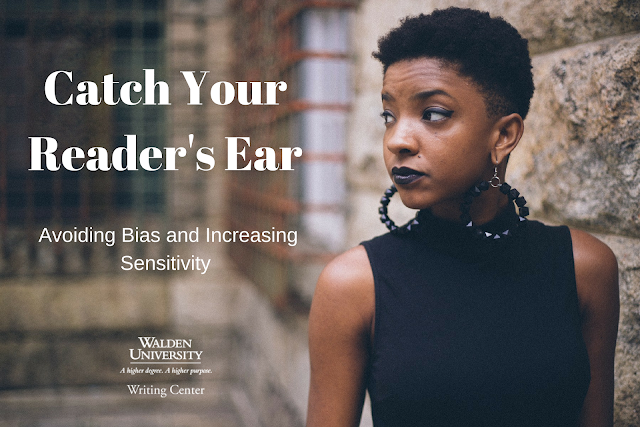Catch Your Reader's Ear: Avoiding Bias and Increasing Sensitivity in Scholarly Writing
Note: This post has been updated per APA 7.Sensitivity in APA style can be a, well, sensitive subject. When we writing instructors receive questions in chat or in paper reviews about sensitivity, students often ask how to be sensitive in their writing—and what sensitivity even means in relation to APA style! The general definition of sensitive applies to APA style in a couple of different ways.
According to the dictionary, a sensitive person has “a quick and delicate appreciation of others’ feelings.” If you have researched how to avoid bias in APA-style writing, this definition makes sense. Sensitivity in APA style does relate to understanding and appreciating the feelings and thoughts of others. However, there is another definition for sensitive that can also be related to sensitivity in APA, and this definition is that a sensitive person is “quick to detect or respond to slight changes, signals, or influences.” You might be wondering how quickly responding to changes relates to APA style, so I’ll return to this second definition after talking a little bit about the general guidelines for avoiding bias and showing sensitivity in APA-style writing.
While there are many ways to ensure sensitivity when writing about groups of people, there are three overarching rules that you can follow to adhere to the APA-style guidelines for sensitivity:
Be specific. It can be tempting to use general terms in an attempt to be polite, but it is almost always best to avoid generalizing. For example, if a writer says, “I interviewed young children,” readers will wonder what constitutes “young.” Does the writer mean toddlers or preteens? If the writer instead says, “I interviewed participants between the ages of 5 and 10,” readers will have a stronger understanding of who the writer interviewed.
Keep terms parallel. It is also important to ensure use of parallel terms when describing groups of people. For example, it wouldn’t be parallel to research how women and males respond to video games. A scholar might instead use men and women. In fact, it’s a best practice to avoid using male and female as nouns in general because these terms are largely used as descriptors, such as when studying male and female penguins, for example.
Use a group’s preferred language. This rule is a little more difficult to follow because different people and different groups prefer different terms. For example, while people-first language is generally the standard for sensitivity in APA, some groups of people, such as autistic children, prefer the descriptor to be used first. It is always a best practice to research preferred descriptors and language when writing about a group of people.
There is one final rule not included in the above list because this rule is principal and supersedes the others: Accept change!
To ensure sensitivity in APA-style writing, it is important to understand that change is constant and that a change in preferred descriptors or language is generally a positive sign of a responsive academic community. For example, at one time, the norm in writing instruction was to only use “they” as a plural pronoun. However, due to changes in language preference in the LGBTQ+ community, we at the Writing Center updated our policy to illustrate our acceptance of gender-neutral pronouns. Change means progress, so being flexible and willing to comply with changing norms can help writers ensure sensitivity and avoid bias in writing.
To that end, the second definition of “sensitivity” that I linked above concerning being responsive to change should now make more sense in relation to sensitivity in APA. While it is important to be sensitive to others’ feelings, it is also important to respond quickly and gracefully to changes in preferred language. By always researching before writing about a specific group of people and by being considerate of changing norms, scholar-practitioners can help contribute to an inclusive atmosphere in academia.
Katherine McKinney is a writing instructor in the Walden University Writing Center. She received an M.A. in English from Valdosta State University in Valdosta, Georgia, and is currently pursuing a Ph.D. in Education at Walden. Katherine's goal as an instructor is to show students that the best writing results from practice, and she aims to provide feedback and resources that will guide students through the invention, composition, and revision process.
.png)
Never miss a new post; Opt-out at any time
Subscribe to:
Post Comments
(
Atom
)





No comments :
Post a Comment